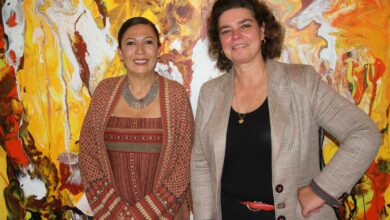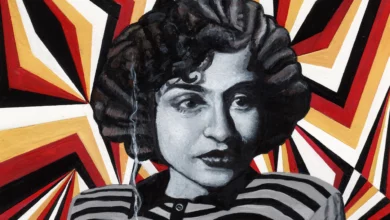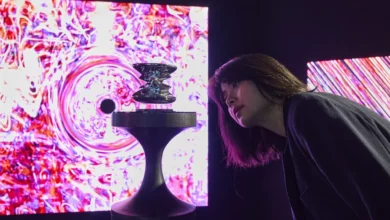A painting of a baby doll missing an eyeball, suspended upside down beside a harlequin marionette; a white butterfly standing on the arm of a doll missing a ring finger and right toes–these are only a few of the pieces in Doll, an exhibition by Danish-Egyptian artist Lise Allam, currently showing at the Gezirah Art Center in Zamalek. The show is a selection of oil and pastel paintings and ink drawings of actual dolls, which the artist collected from family members and friends and bought from Cairo’s famous Friday flea market. The technique is interesting and the images of mutilated and dismembered dolls highly disturbing, creating an unsettling mood that is heightened by displays of broken plastic dolls and doll heads–the subjects of the paintings–in glass vitrines at the center of the gallery space.
So what does all this mean? Allam, a textile designer who started painting in the nineties, is fascinated by dolls, which she considers a universal symbol of childhood innocence. She is amazed by how teenagers casually throw out once-cherished dolls as a sign of their transition into adulthood. They seek to replace the obsolete dolls with “grown-up products” like make-up and clothes. Allam sees this as a sign of increasing consumerism, which promotes only transient attachment to objects.
This urge to grow up is present in Stilettos, an oil painting of a blond doll in a red dress and a pair of over-sized high heels. Tenera, a painting of a ghost-like doll standing alone with her arms slightly raised in a call for attention, is about abandonment.
Allam aims to represent the stories of the dolls and their original owners. One oil and charcoal painting has text for a background, which Allam imagined to be the diary of the doll’s owner; the doll, Grete, “was the best dressed doll in town.”
Early paintings in the series are exact depictions of the dolls with dark overtones, often highlighting their degraded state. In later works, the artist’s intervention is clearer and the need to focus on the expired state of the dolls dwindles. The backgrounds become brighter and more lively and the dolls are given human, childlike attributes, as in Stilettos. She tries to restore the innocence and buoyancy in the dolls by placing them in natural settings. In an oil painting called Butterfly I, Allam replaces a doll’s missing head with a giant yellow butterfly “to give it new life,” she explains. Nevertheless, the images remain unsettling. The artificiality of the dolls is emphasized by their animated portrayal and creates a barrier to engaging with the work on emotional and intellectual levels.
Interesting as a topic at the outset, Doll promises more than it offered. In the end, the exhibition is more successful in conveying the the long relationship the artist developed with her subjects than critiquing widespread consumerist values. Some of the most interesting pieces in the exhibit are the artist’s sketches that show her experimentation with media and form. It remains doubtful that Doll will encourage anyone to revisit their perceptions about adulthood and consumerist values, but it’s a revealing display of Allam’s evolution as a painter.
Doll is exhibited at the Gezirah Art Center form 4-18 October, 2010
1 El Marsafi Street, Zamalek
The gallery is open daily from 10 to 14 and from 17 to 21, except Fridays




